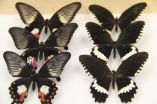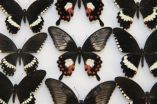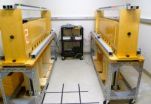(Press-News.org) A single gene regulates the complex wing patterns, colors and structures required for mimicry in swallowtail butterflies, report scientists from the University of Chicago, March 5 in Nature. Surprisingly, the gene described, doublesex, is already well-known for its critical role in sexual differentiation in insects.
"Conventional wisdom says that it should be multiple genes working together to control the whole wing pattern of a butterfly," said Marcus Kronforst, Neubauer Family Assistant Professor of Ecology & Evolution at the University of Chicago and senior author of the study. "But in this case, it's just this one. This single gene that controls sexual differentiation has been co-opted to do a totally new job."
Studied as an example of natural selection for centuries, wing pattern mimicry in butterflies enables non-toxic species to mimic the pattern, color and shape of a toxic species' wings to deter predation. A single region of the genome regulates this process in some swallowtail butterflies. Due to the complexity of forms involved with mimicry, researchers have assumed this region contained a "supergene"—multiple tightly-linked genes, each controlling a subset of the wing pattern. However, little was known about this hypothesized mimicry supergene.
To identify its function, Kronforst and his team studied Papilio polytes, an Asian swallowtail butterfly species that displays sex-limited mimicry. Females possess one of four different wing patterns, three of which mimic toxic species, while the remaining female form and all males remain non-mimetic.
Through a genetic mapping process that involved mating butterflies of differing wing patterns and comparing the genomes of around 500 offspring, the team identified five possible genes involved in mimicry. They then sequenced the genomes of 30 butterflies, evenly split between mimetic and non-mimetic, and looked for correlations between these specific genes and wing pattern.
To their surprise, only one, doublesex, showed an association. Well established as a gene that controls sexual differentiation in insects, doublesex functions through alternative splicing. When copied into messenger RNA, it is cut and rearranged into different isoforms, which then go on to instruct cells whether they should be male or female.
Kronforst and his team found that doublesex is also alternatively spliced into multiple isoforms in Papilio polytes. Two in particular were expressed at extremely high levels in the wings of mimetic butterflies when compared to non-mimetic females. Tracing the doublesex protein from caterpillar to chrysalis to butterfly, the team found expression of doublesex overlaps exactly with wing pattern.
"When you look at the wing tissue in a chrysalis five days after it forms the pupa, it's just a floppy piece of white tissue," Kronforst said. "But when you look at where doublesex is being manufactured on the wing, it looks just like the future adult wing pattern."
How one gene controls so many different functions remains unclear. Kronforst suggests that noncoding, regulatory DNA that controls when and where doublesex is expressed may play a role. The team also found that in mimetic butterflies, the doublesex gene is inverted on the genome. This inversion eliminates the possibility of recombination—alleles will remain distinct from each other and accumulate differing mutations. This has led to structural differences in the doublesex protein between mimetic and non-mimetic butterflies. Because doublesex is a transcription factor and activates other genes, the researchers believe these differences may also contribute to wing pattern variation.
"We've illustrated the genetic basis of female-limited mimicry in these butterflies," said Wei Zhang, PhD, postdoctoral fellow at the University of Chicago and a lead study author. "But this is just the first step. How doublesex became involved in this process is still uncertain, and requires further study."
Study lead author Krushnamegh Kunte, PhD, of the National Center for Biological Sciences in Bengaluru, India, and a former postdoctoral fellow in the Kronforst lab, anticipates future research will determine if this type of phenomenon will be found in other species. "Across animal species, we find examples where polymorphisms occur in one sex or the other," he said. "We're studying it in the context of mimicry, but it's possible that this sex differentiation pathway that we found in butterflies could be a pathway that's more broadly important for sex-limited polymorphism."
INFORMATION:The paper, "doublesex is a mimicry supergene," was supported by the National Science Foundation. Additional authors include Ayse Tenger-Trolander, Daniela H. Palmer, Arnaud Martin, Robert D. Reed and Sean P. Mullen.
A single gene, doublesex, controls wing mimicry in butterflies
2014-03-05
ELSE PRESS RELEASES FROM THIS DATE:
Ultra sensitive detection of radio waves with lasers
2014-03-05
Radio waves are used for many measurements and applications, for example, in communication with mobile phones, MRI scans, scientific experiments and cosmic observations. But 'noise' in the detector of the measuring instrument limits how sensitive and precise the measurements can be. Now researchers at the Niels Bohr Institute have developed a new method where they can avoid noise by means of laser light and can therefore achieve extreme precision of measurements. The results are published in the prestigious scientific journal, Nature.
'Noise' in the detector of a measuring ...
Livestock can produce food that is better for the people and the planet
2014-03-05
With one in seven humans undernourished, and with the challenges of population growth and climate change, the need for efficient food production has never been greater. Eight strategies to cut the environmental and economic costs of keeping livestock, such as cows, goats and sheep, while boosting the quantity and quality of the food produced have been outlined by an international team of scientists.
The strategies to make ruminant - cud-chewing - livestock a more sustainable part of the food supply, led by academics at the University of Bristol's School of Veterinary ...
ALS-linked gene causes disease by changing genetic material's shape
2014-03-05
Johns Hopkins researchers say they have found one way that a recently discovered genetic mutation might cause two nasty nervous system diseases. While the affected gene may build up toxic RNA and not make enough protein, the researchers report, the root of the problem seems to be snarls of defective genetic material created at the mutation site.
The research team, led by Jiou Wang, Ph.D., an assistant professor of biochemistry and molecular biology and neuroscience at the Johns Hopkins University School of Medicine, reports its finding March 5 on the journal Nature's ...
Study aims to define risk factors for falls in post-menopausal women
2014-03-05
ROSEMONT, Ill.–A new study appearing in the March issue of the Journal of Bone and Joint Surgery (JBJS) showed that women with distal radius (wrist) fractures had decreased strength compared to similar patients without fractures. This could explain why these women were more likely to fall and might sustain future fractures.
The investigators used a variety of balance and strength tests combined with patient-provided information about walking habits to evaluate the physical performance and risk of falls for post-menopausal women with and without previous wrist fractures. ...
UF researchers find drug therapy that could eventually reverse memory decline in seniors
2014-03-05
GAINESVILLE, Fla. — It may seem normal: As we age, we misplace car keys, or can't remember a name we just learned or a meal we just ordered. But University of Florida researchers say memory trouble doesn't have to be inevitable, and they've found a drug therapy that could potentially reverse this type of memory decline.
The drug can't yet be used in humans, but the researchers are pursuing compounds that could someday help the population of aging adults who don't have Alzheimer's or other dementias but still have trouble remembering day-to-day items. Their findings will ...
NASA sees Tropical Cyclone Faxai stretching out
2014-03-05
When a tropical cyclone becomes elongated it is a sign the storm is weakening. Imagery from NASA-NOAA's Suomi NPP satellite today revealed that wind shear was stretching out Tropical Cyclone Faxai and the storm was waning.
On March 5 at 1500 UTC/10 a.m. EST, Tropical Cyclone Faxai's center was located near 22.5 south and 155.2 east, about 699 nautical miles/804.4 miles/ 1,295 km west-northwest of Wake Island. According to the Joint Typhoon Warning Center or JTWC, Faxai's maximum sustained surface winds dropped to 50 knots/57.5 mph/92.6 kph. Faxai was moving to the northeast ...
UCSB study explores cocaine and the pleasure principle
2014-03-05
(Santa Barbara, Calif.) — On the other side of the cocaine high is the cocaine crash, and understanding how one follows the other can provide insight into the physiological effects of drug abuse. For decades, brain research has focused on the pleasurable effects of cocaine largely by studying the dopamine pathway. But this approach has left many questions unanswered.
So the Behavioral Pharmacology Laboratory (BPL) at UC Santa Barbara decided to take a different approach by examining the motivational systems that induce an animal to seek cocaine in the first place. Their ...
First-ever 3D image created of the structure beneath Sierra Negra volcano
2014-03-05
The Galápagos Islands are home to some of the most active volcanoes in the world, with more than 50 eruptions in the last 200 years. Yet until recently, scientists knew far more about the history of finches, tortoises, and iguanas than of the volcanoes on which these unusual fauna had evolved.
Now research out of the University of Rochester is providing a better picture of the subterranean plumbing system that feeds the Galápagos volcanoes, as well as a major difference with another Pacific Island chain—the Hawaiian Islands. The findings have been published in the Journal ...
Brain circuits multitask to detect, discriminate the outside world
2014-03-05
Imagine driving on a dark road. In the distance you see a single light. As the light approaches it splits into two headlights. That's a car, not a motorcycle, your brain tells you.
A new study found that neural circuits in the brain rapidly multitask between detecting and discriminating sensory input, such as headlights in the distance. That's different from how electronic circuits work, where one circuit performs a very specific task. The brain, the study found, is wired in way that allows a single pathway to perform multiple tasks.
"We showed that circuits in the ...
Similarity breeds proximity in memory, NYU researchers find
2014-03-05
Researchers at New York University have identified the nature of brain activity that allows us to bridge time in our memories. Their findings, which appear in the latest issue of the journal Neuron, offer new insights into the temporal nature of how we store our recollections and may offer a pathway for addressing memory-related afflictions.
"Our memories are known to be 'altered' versions of reality, and how time is altered has not been well understood," said Lila Davachi, an associate professor in NYU's Department of Psychology and Center for Neural Science and the ...






